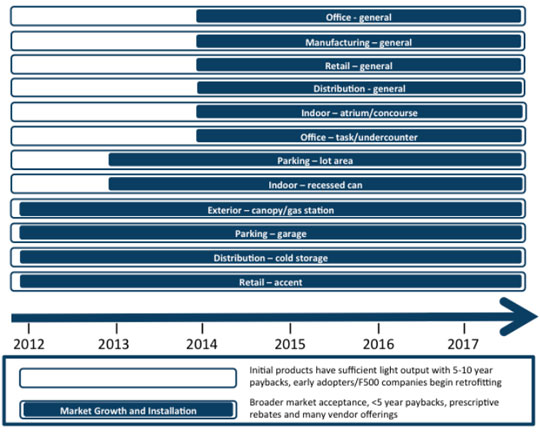The U.S. General Services Administration , Largest Tenant in US, has turned its attention to LEDs.
According to the GSA, energy efficiency is becoming a way of life, not only to cut costs at more than 9,600 assets that it owns or rents, but also to meet the 2007 federal mandate that government buildings slash energy consumption 30 percent by 2015.
To meet those goals, and to push the whole market forward, it launched the Green Proving Ground program to evaluate sustainable building technologies. Based on performance, the GSA can then recommend technologies to its portfolio.
The GSA has already published findings on occupant-responsive fluorescent lighting, but now it has turned its attention to LEDs and controls.
As part of the Recovery Act, the GSA had more than 200 projects of lighting retrofits, but few were LEDs. “The Green Proving Ground GPG program is looking at the next generation of products that are targeting general office lighting, which is the great frontier,” said Kevin Powell, program manager for Green Proving Ground. The frontier has certainly moved to LEDs, which have come down significantly in price.
For most office applications, a report from Groom Energy and GTM Research estimates that large market adoption for LEDs (with a less than five-year payback) is approaching and will probably come in another year.

As part of this year’s Green Proving Ground pilots, the GSA is testing LED Troffers from Cree and wireless controls from Daintree Networks. The technologies will be tested separately and together, with results expected in early 2014.
The GSA likes to test technologies in various settings to get an idea of what applications are right for what space -- whether it’s a 9-5 office or a 24-hour call center. The bulk of GSA’s footprint is office space.
Daintree’s ControlScope solution will be used to control existing fluorescent lights in one building and to control Cree’s lights in another building. Powell notes that one of the advantages of LEDs is their inherent controllability, but the agency still doesn’t know if the cost-benefit is right.
“The point is to see whether or not we can cost-effectively install that at market prices today,” said Powell. But cost isn’t the only factor; occupant satisfaction and maintainability also play a part in evaluating technology.
In the case of occupant responsive lighting, the technology saved 27 percent over baseline conditions for spaces illuminated 12 hours a day, five days a week -- and occupants embraced the upgrades. For LEDs, the savings will have to significantly beat what’s achievable with controllable fluorescents to make inroads with GSA.
Daintree Networks and Cree are already working together with the Sacramento Municipal Utility District, delivering the joint solution at a wholesale distributor. The retrofit to the office and breakroom resulted in more than 91 percent savings.
Once the GSA has completed findings, then it can recommend technologies to some or all of its portfolio. With more than 370 million square feet of building stock, if the GSA widely implements a technology, it can easily push the entire market forward.
For the federal agency, 2015 isn’t the endgame when it comes to meeting energy efficiency goals. Even once that mandate is met, the GSA then needs to turn its focus to net-zero energy designs by 2020, said Powell, who noted that taking the heat out of lighting by using LEDs will likely be a component of those designs. We have a great deal of incentive to roll out technologies that prove out as quickly as possible,” he said.












